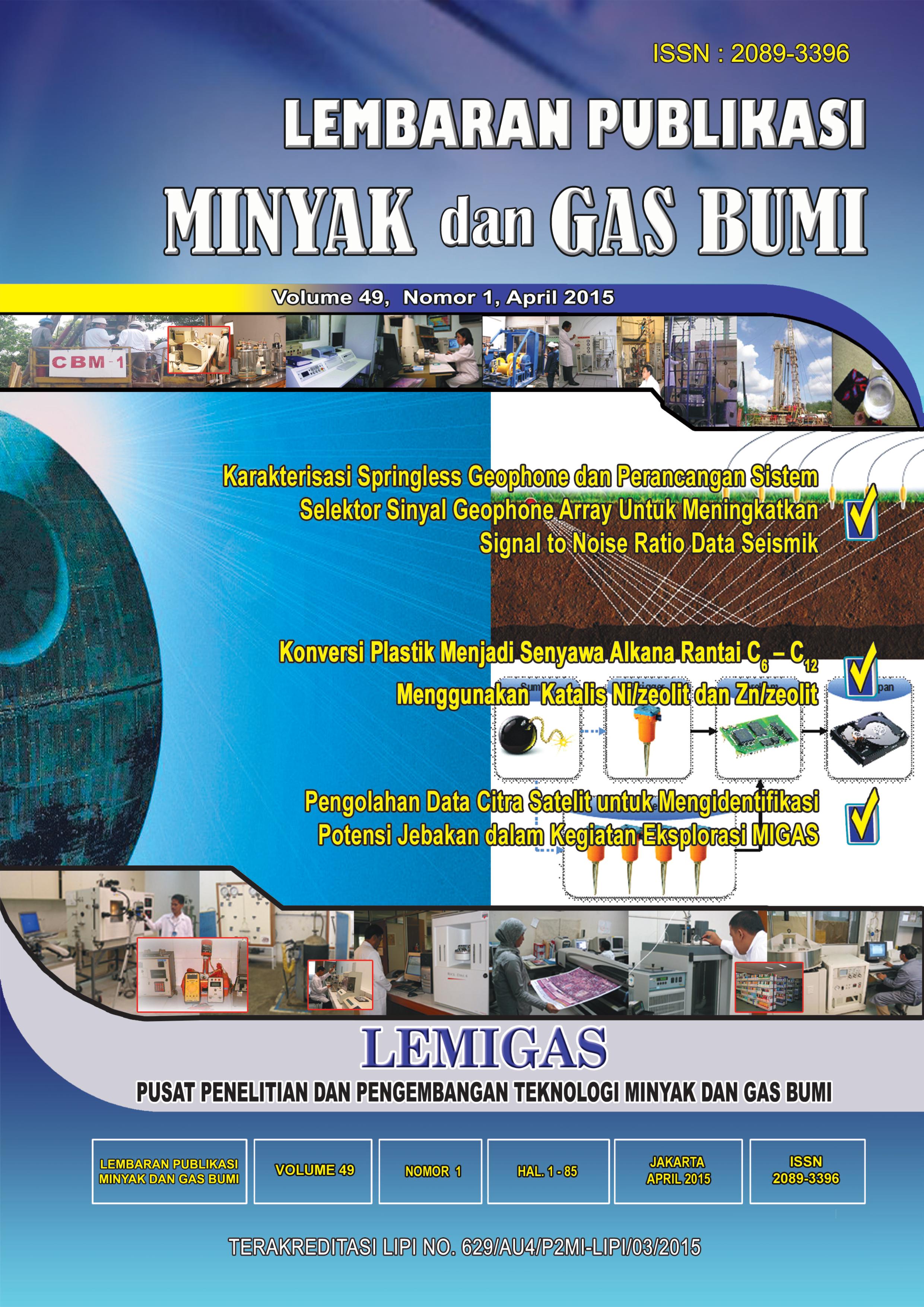Karakterisasi Springless Geophone dan Perancangan Sistem Selektor Sinyal Geophone Array untuk Meningkatkan Signal to Noise Ratio Data Seismik
DOI:
https://doi.org/10.29017/LPMGB.49.1.231Kata Kunci:
springless geophone, seismik, geophone array, noiseAbstrak
Geophone adalah gerbang pertama informasi citra bawah permukaan bumi pada survei seismik. Akurasi geophone memainkan peranan yang sangat penting pada survei tersebut. Hampir semua geophone yang berada di industri berbasis pegas. Masalah utama yang muncul pada geophone jenis pegas adalah perubahan nilai k (konstanta pegas) akibat pembebanan terus menerus. Perubahan nilai tersebut akan berpengaruh pada akurasi sinyal seismik yang dihasilkan. Untuk mengatasi permasalahan tersebut, sebuah geophone berbasis magnet yang menggunakan gaya tolak menolak magnet sekutub sebagai pengganti pegas telah dikembangkan dan dinamakan springless geophone. Secara kualitatif, springless geophone dapat mempunyai frekuensi alami yang lebih baik dibandingkan geophone konvensional namun nilai sensitivitasnya lebih rendah. Permasalahan lain juga muncul pada sistem perekaman. Geophone array yang hanya dikongurasi dengan kombinasi seri-paralel menyebabkan error atau noise dari masing- masing geophone tidak dapat terdeteksi. Sebuah sistem selektor sinyal seismik telah dirancang untuk menghilangkan permasalahan error tersebut. Sistem tersebut bekerja dengan mengevaluasi sinyal dari masing-masing geophone, kemudian menyeleksi sinyal-sinyal yang identik dan mengeliminasi sinyal- sinyal yang tidak identik sehingga sinyal yang direkam hanya sinyal-sinyal yang identik. Jika nilai sinyal geophone terletak di antara batas atas dan batas bawah lter, maka sinyal dinilai identik. Jika tidak maka sinyal harus dieliminasi. Batas atas lter adalah penjumlahan dari nilai rata-rata dan deviasi standar sinyal geophone dalam satu grup. Sedangkan batas bawah adalah nilai rata-rata dikurangi deviasi standar.
Geophone is the rst gateforsubsurface informationonseismic survey. Geophone accurationplays very im- portant role in this survey. Most of industrial geophoneis spring-based. The main problem of spring-based geophone is the change of k value (spring constant) because of load continuously. The change of k value will reduce the accuration ofthe observedseismic data. To solve this problem, a magnet-based geophone whichusesrepulsion force of magnetstosubstitutethe use of springhas been developedand named springless geophone. Qualitatively, the springless geophone has betternatural frequency than conventional one but the sensitivity is lower. Another problem also takes place in recording system.Array geophone which is congured by series and parallel combination causeserror or noise from each geophone can not be detected. A geophone array signal selector systemhas been designedto solve this problem. This system evaluates signal fromeach geophone simultaneously, then selectssome identical signals, and eliminatesunidentical signals so that only identical signal that will be recorded. If geophone signal is between top level and bottom level of lter, then the signal is considered as identic. If not, then the signal must be eliminated. Top level of the lter is addition of average and standard deviation of group geophones signals. Bottom level of lter is the difference between average and standard deviation.
Referensi
Brincker, R., Lagö, T.L.et al., 2005.Improving the Classical Geophone Sensor Element by Digital Correction.23rd International Modal Analysis Confer- ence (IMAC), Orlando, Florida.
Gadallah, M.R., Fisher, R.L., 2005.Applied Seismology: A Comprehensive Guide to Seismic Theory and Ap- plication. Pennwell.Oklahoma.
Johnson, D.H., & Dudgeon, D. E.,1993. Array Signal Processing: Concepts and Techniques. PTR Prentice Hall.New Jersey.
McQuillin, R., Bacon, M.,& Barclay, W., 1984. An Introduction to Seismic Interpretation: Re ection Seismic in Petroleum Exploration. Gulf Publishing. Houston.
O’Brien, P.N.S., 1964.Geophone Distorsion of Seismic Pulses and its Compensation. Twenty Sixth Meeting of The European Association of Exploration Geophysics in Pau, 19.
Palmer, R. A., 1964. A New Technique For The Measurement of Geophone Parameter under Fields Conditions. Twenty Sixth Meeting of The European Association of Exploration Geophysics in Pau, 423.
Rost, S.,Thomas, C., 2002. Array Seismology: Methods and Applications.American Geophysical Union. Reviews of Geophysics, 40, 3.
Sismanto., 1996. Pengolahan Data Seismik. Universitas Gadjahmada. Yogyakarta.
Stark, A., 2008. Seismic Methods and Applications: A Guide for the Detection of Geologic Structures, Earthquake Zones and Hazards, Resource Exploration, and Geotechnical Engineering. BrownWalker Press.Florida.
Stone, D. G., 1994. Designing Seismic Surveis in Two and Three Dimensions. Society of Exploration Geophysicists.Oklahoma
Streickeisen et al., 1982. Design and Performance, The Leaf-Spring Seismometer,72, 2352.
Thomson, W. T., 1981. Theory of Vibration with Application, 2nd edition. Prentice Hall. New Jersey.
Yilmaz, Ö., 1987. Seismic Data Processing. Society of Exploration Geophysicists.Oklahoma.











